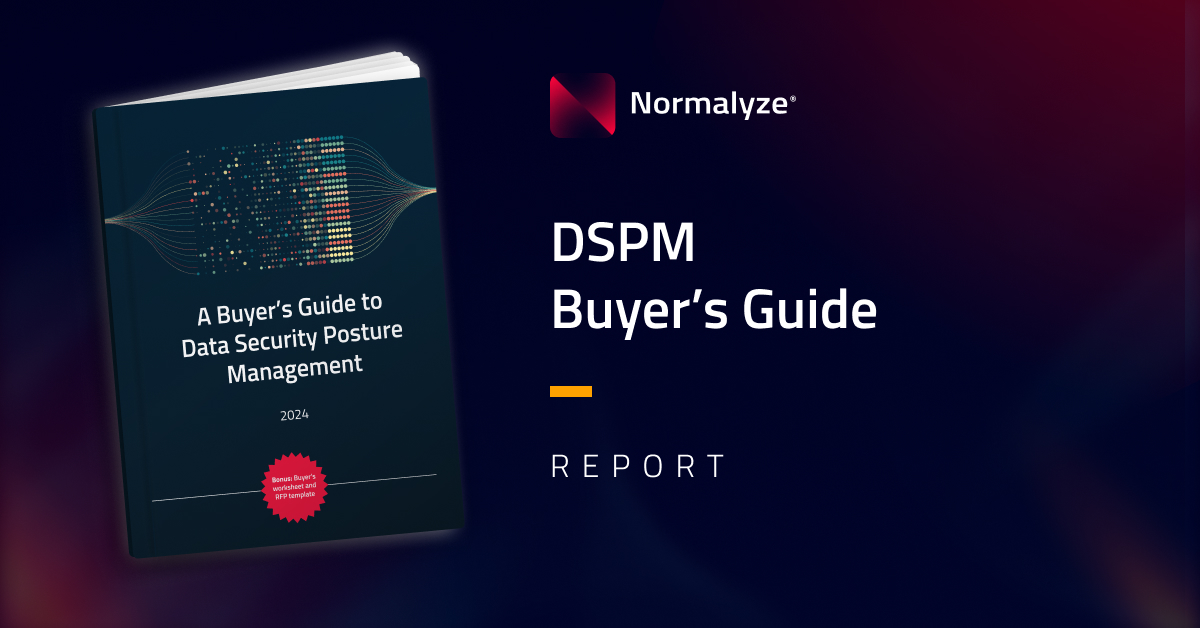I’m excited to share a recent conversation I had with GigaOm analyst Paul Stringfellow about how DSPM and a data-centric approach are essential to data security. Paul and I discussed our perspectives on the challenges businesses face – which are significant – as well as features of a success DSPM solution and how DSPM can be an enabler for the business.
Paul and I keyed our conversation off the latest GigaOm Radar on Data Security Posture Management (DSPM). The report sheds light on data security challenges and offers valuable insights and solutions for enhancing data security in modern enterprises.
How a Data-Centric Approach Improves Data Security
Paul put it perfectly when he said, “Data is critical to the way businesses are operating, and it’s only going to become more important as we carry out more analytics, use machine learning, and of course, we couldn’t do any kind of technical conversation without using the acronym AI.” He emphasized the necessity for robust data security solutions, and I couldn’t agree more.
Data Security Posture Management (DSPM) is a fundamental concept that prioritizes understanding and protecting data itself, regardless of where it resides. Unlike traditional security measures built around technology or location, DSPM focuses on the data’s intrinsic value and context. It plays a crucial role in addressing the challenges posed by data sprawl and the need for visibility and control over dispersed critical data.
DSPM helps organizations comprehend the “five W’s” of data: where it is, what it is, when it is used, who uses it, and why. This comprehensive understanding is essential for mitigating risks, ensuring compliance, and enabling businesses to leverage their data effectively.
Data Security: Challenges and Solutions
Paul and I discussed the challenges organizations face. As Paul put it, “If we don’t know what data we have, and we have data that we shouldn’t have, we have data that’s not controlled, it presents a massive security risk. Ultimately, for cyber attackers, data tends to be the target. Whether it’s stealing data, encrypting data so that you can’t read it, or making it inaccessible, data is core to the way modern cyber attackers work. DSPM is hugely important in solving this.”
The importance of DSPM is rising as data spreads across cloud environments, SaaS platforms, and on-premises systems. Security teams face the challenge of regaining control and visibility over this dispersed data, and DSPM solutions are pivotal in discovering, classifying, and securing data across diverse environments.
Features of an Effective DSPM Solution
Several key aspects make DSPM solutions indispensable for modern businesses:
- Broad Coverage: An effective DSPM solution must identify data and assess risks across various platforms, including SaaS, PaaS, IaaS, and on-premises environments.
- Data Discovery and Classification: Understanding what data is important is crucial. DSPM tools must be able to discover data in known and unknown repositories and classify it with high accuracy based on its importance to the organization.
- Risk Reduction and Compliance: By knowing where the risks are, organizations can apply appropriate security measures, such as data loss prevention, anonymization, masking, and encryption. Compliance with regulations like GDPR is also a significant driver for DSPM adoption.
- Clear Risk Presentation: Presenting risks in a clear and understandable manner is vital. Effective DSPM solutions assign a monetary value to data risks, helping organizations prioritize their security efforts.
- Detection and Response: Beyond identifying risks, DSPM solutions must offer actionable remediation steps and the ability to automate these processes to effectively mitigate threats.
Additional Key Features
DSPM solutions should also scan data in its original location without copying it outside, to avoid the additional data, access, and compliance risks that copying data creates. Solutions should offer broad coverage, discovering and classifying data with high accuracy, assessing risks, and ensuring compliance. They should make use of advanced technologies like natural language processing and AI to identify and prioritize attack paths that could lead to sensitive data and accelerate remediation.
“CMDB, CSPM, CASB, and CIEM tools all help from a siloed approach around understanding some risk factor around the data, but that alone doesn’t give you the full information you need to connect all these dots in an intelligent way,” I noted during the webinar. “Determining exactly where the important data is, what’s at risk, and if there are any attack paths that can be exploited through an external or internal attacker is critical for preventing data breaches.”
DSPM as Business Enabler
“DSPM brings us business enablement. Without it, if we don’t know what information we have, how can we secure it? How can we know where our risks are? How can we effectively use that data on a day-to-day basis to drive our business?” Paul pointed out. For example, DSPM enables the effective and secure use of AI systems by enabling organizations to understand and control the inputs into generative AI systems.
For businesses looking to improve their data security, investing in a robust DSPM solution is a strategic move. The insights and innovative approaches outlined in the GigaOm Radar report underscore the importance of staying ahead in the ever-evolving field of data security.
If you want to hear the entire conversation, it’s available on demand at Analyst Insights: GigaOm Radar Report for Data Security Posture Management.


